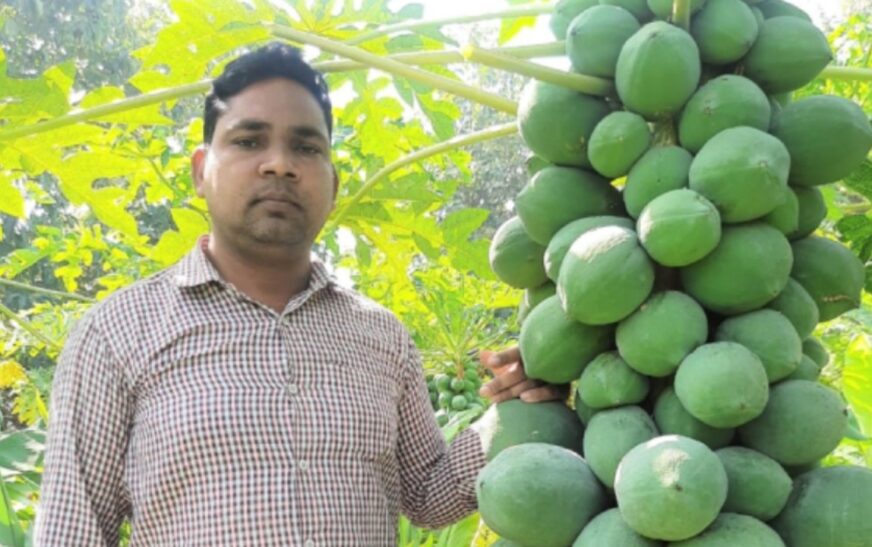Abhay Pratap, a farmer hailing from Aliyapur, Shamsabad Nagar Panchayat in Farrukhabad district, Uttar Pradesh, has spearheaded a transformative approach to intercropping. His innovative methodology involves combining papaya cultivation with a diverse array of vegetables such as potato, carrot, radish, yam, and turnip, alongside the cultivation of flowers like marigold, tuberose, and gladioli. Commencing commercial papaya farming in 2009 across 6 acres of land, Abhay embarked on a journey that not only revolutionized his intercropping practices but also offered valuable insights to the agricultural community at large.
In an exclusive conversation with The Interview World, Abhay, the owner of Abhay Kheti Se Pragati Agriculture Farm, elaborates on the manifold benefits of intercropping. He emphasizes how this approach not only enhances yield and crop diversity but also contributes significantly to the profitability and sustainability of farming operations.
Q: How did you become interested in intercropping?
A: Feeding a population exceeding a billion in a densely populated nation like India presents an unparalleled challenge. With the population expanding exponentially, agricultural land is dwindling at an alarming rate. To confront this pressing issue, farmers must transition from conventional farming techniques to intercropping, enabling the simultaneous cultivation of multiple crops.
Reflecting on my agricultural journey, my venture into papaya farming in 2009 sparked a question: why restrict ourselves to papaya alone when its plantation requires specific plant spacing? Embracing a mindset of exploration, I diversified my crops by introducing yam, potato, and turnip alongside papaya.
Furthermore, I broadened the spectrum by integrating flowering plants such as marigolds, tuberose, and gladioli into my farming practices. This strategic diversification not only optimizes land usage but also enhances overall farm productivity, contributing to the sustainable feeding of the nation’s burgeoning population.
Q: How would you describe the unique characteristics of the papaya variety you’re cultivating?
A: I’m thrilled to introduce D1, my latest papaya variety, boasting a remarkable yield potential of 40-100 kg per plant. Notably, the seeds come at a fraction of the market price, marked at 12-15 times less. D1 also showcases impressive disease-resistant properties, ensuring a robust and healthy harvest.
Now available for purchase are 100 gm papaya seeds at an affordable rate of Rs. 2,500, catering to farmers in Madhya Pradesh, Maharashtra, Bihar, and Haryana. With D1, farmers have the opportunity to reap substantial rewards, potentially earning up to Rs. 3 lakhs in profit per acre within a single season.
Q: How do papayas contribute to economic prosperity beyond their traditional uses?
A: Papaya presents a multitude of economic benefits, extending beyond its conventional roles as both a vegetable and a fruit in the market. Beyond its culinary versatility, papaya serves as a pivotal ingredient for the production of an array of products, including cherries, pickles, and sweets, thus expanding its economic value chain. This diversification not only broadens the market potential for papaya but also enhances its profitability for farmers.
As farmers embrace higher levels of papaya processing, they stand to reap significant rewards along the value chain. By harnessing the potential of papaya as a base material for various products, farmers can tap into new revenue streams and bolster their economic sustainability. Furthermore, this shift towards value-added processing not only increases the marketability of papaya-derived products but also contributes to the overall economic growth and resilience of agricultural communities.
Q: How can farmers effectively implement intercropping practices to optimize crop yields and sustainability?
A: Intercropping presents a promising opportunity for farmers to enhance their agricultural practices and amplify their yields. By integrating diverse crops within the same field, such as vegetables and flowers, farmers can exploit synergies that promote soil health, pest control, and nutrient cycling. This method optimizes land usage and fosters sustainable farming practices, leading to increased productivity and profitability.
Moreover, intercropping reduces the risk of crop failure and provides a buffer against adverse weather conditions. As farmers embrace intercropping, they not only diversify their income streams but also contribute to biodiversity conservation and ecological resilience. Harnessing the potential of intercropping enables farmers to adapt to changing agricultural landscapes and secure a more stable and prosperous future for themselves and their communities. With strategic planning and knowledge-sharing, intercropping can emerge as a cornerstone of modern farming practices, enriching both the environment and the livelihoods of farmers worldwide.










1 Comment
I would like to thank you for the efforts you have put in writing this website. I’m hoping the same high-grade site post from you in the upcoming as well. Actually your creative writing abilities has inspired me to get my own website now. Actually the blogging is spreading its wings quickly. Your write up is a good example of it.
Comments are closed.